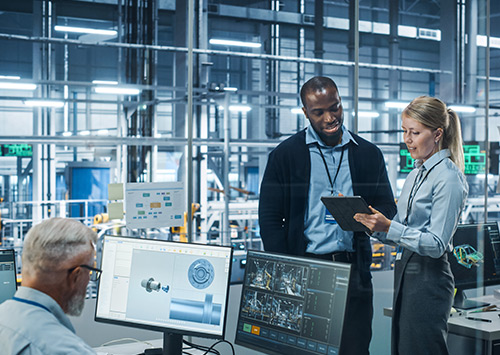- Services
Technology Capabilities
Technology Capabilities- Product Strategy & Experience DesignDefine software-driven value chains, create purposeful interactions, and develop new segments and offerings
- Digital Business TransformationAdvance your digital transformation journey.
- Intelligence EngineeringLeverage data and AI to transform products, operations, and outcomes.
- Software Product EngineeringCreate high-value products faster with AI-powered and human-driven engineering.
- Technology ModernizationTackle technology modernization with approaches that reduce risk and maximize impact.
- Embedded Engineering & IT/OT TransformationDevelop embedded software and hardware. Build IoT and IT/OT solutions.
- Industries
- GlobalLogic VelocityAI
- Insights
BlogsMarch 15, 2023GlobalLogicIf You Build Products, You Should Be Using Digital Twins
Digital twin technology is one of the fastest growing concepts of Industry 4.0. In the ...
 BlogsJanuary 25, 2023GlobalLogic
BlogsJanuary 25, 2023GlobalLogicDeploying a Landing Zone with AWS Control Tower – Part 3
In this post, we’re going to walkthrough some of the remaining post configuration tasks...
- About
Published on January 27, 2023ChatGPT and what makes us human
View all articles Dr. Jim WalshCTOShareRelated Content
Dr. Jim WalshCTOShareRelated Content GlobalLogic16 July 2025
GlobalLogic16 July 2025 GlobalLogic16 July 2025View All Insights
GlobalLogic16 July 2025View All Insights GlobalLogic25 June 2025
GlobalLogic25 June 2025Let's start engineering impact together
GlobalLogic provides unique experience and expertise at the intersection of data, design, and engineering.
Get in touchAI GovernanceMLOpsCross-IndustrySince the AI-driven chatbot “ChatGPT” was introduced to the public in November 2022, it has been a hot topic for discussion. The ability of AI-based technology to perform characteristically ‘human’ tasks such as telling stories, writing code, authoring poetry, telling jokes and composing essays on virtually any topic has shocked and astonished many.These activities are among those that we think of as particularly human. If a software package can do these very human tasks, what does it mean to be human?
I’m pretty sure that humanity has asked a variant of this question every time a new technology has appeared. Probably the invention of the wheel was greeted with dismay by some because lifting and carrying items—or transporting those items on a horse or donkey—was thought of at the time as a human or animal task. Not something to be done by an inanimate object such as this new ‘wheel’ gadget.
Does ChatGPT spell the end of human creativity?
The AI-driven chatbot invention strikes particularly close to home for me, however, because what I’ve conventionally seen myself as being good at is making associations between concepts that might seem very different. This can be a simple association like answering a question for my colleagues like, “Where has GlobalLogic done something similar to this project before?” My experience, memory, and ability to make associations have served me well in helping me answer this type of question.
Such questions are a bit harder to answer and require more creativity than might appear at first glance because GlobalLogic has hundreds of clients and does literally thousands of projects per year. Also, associations can happen across many dimensions—similar technology, similar business problem, similar situation, and so on. GlobalLogic of course does have search and other electronic means of answering most such questions. Nonetheless, for the hard or critical ones—those requiring ‘lateral’ thinking–I’ve been a good resource and am frequently called on to answer this type of question.
Recommended reading: The AI-Powered Project Manager
Likewise, I enjoy writing: essays, stories, and even the occasional bit of poetry. I think writing is good when people can relate to the author’s experiences or narrative, and when it makes sometimes unexpected associations that people might find interesting, funny, or engaging. When I write, I know that I certainly aspire to do this. What is surprising and a bit disconcerting, to me and I think to others, is that the AI-driven ChatGPT does a pretty good job at both! I’ve seen ChatGPT make some fairly surprising—but valid—associations, and it can even describe situations in a way that is emotionally moving. Its grammar is also fluid, and readable.
Relatable story-telling and surprising associations were generally thought of as uniquely human activities requiring creativity. The fact that a mechanical process can do both, and do them fairly well—even in its relative infancy—is disconcerting to many of us.
Advances in AI are helping us redefine what it means to be human.
However, much of creativity—human or otherwise—has always been about forging associations between items previously thought to be different. For example, between green-colored rocks and copper; between “my love” and “a summer’s day”; between space and time. Indeed, it would be more surprising if a software process that can read, process, and classify all of the literature; all of the scientific knowledge; and literally everything written, did NOT make some surprising connections. The programming challenge would be more around pruning the possible associations for relevancy, rather than generating the possible associations in the first place.
In prehistory, the inventions of storytelling and drawing, and many thousands of years later, of writing, were considered milestones in the human journey. All of these enabled one person to leverage the experiences gained by others, expanding what a single person could know and do.
The introduction of the printing press 500 years ago multiplied this capability by making the writings, drawings, and stories of others available to a wider audience. More recently—arguably starting in the 1990s—the large-scale digitization of printed content, along with the generation of digital-native content such as blogs and websites, eliminated the need for the physical production of printed media before information could be consumed. This had the effect of drastically lowering the cost of distribution and making more content available to a wider audience than had ever before been possible.
Many of us did not appreciate the full implications at the time: digitized content is also machine-readable. Therefore, not only people but also software can use it to ‘learn’. We knew this in a limited sense, with powerful search engines and knowledge digests such as those provided by Google, Microsoft, and others being part of our lives for decades. However, a general-purpose, interactive AI that itself digests and synthesizes this information in ‘creative’ ways is new to many of us and has become a fact we must all come to terms with.
Recommended reading: Cloud-Driven Innovations: What Comes Next?
Throughout the history of technology, many inventions and discoveries have forced people to rethink and redefine who they are, and what it means to be ‘human.’ One such instance was the Copernican revolution in the 1500s, where it became widely accepted that the Earth goes around the Sun rather than vice-versa. This required a major shift in humanity’s thinking about our central role—or lack thereof—in the universe. But many smaller inventions and discoveries have had deep consequences on our individual identities when our identity has become tied up with a particular capability.
One example from American Folklore is told in “The Ballad of John Henry.”
John Henry is a man who works building the railroads of pre-Civil War America (before 1861), manually using a hammer to pound in the nails that held the tracks. His pride is his speed and physical strength. When the technical innovation of the steam drill is introduced, John Henry is defiant and refuses to admit that this new mechanical device could perform his job as well as he could. He says to his boss (the “captain”), who has introduced this new machine:
John Henry said to his captain,
“A man is nothing but a man,
But before I let your steam drill beat me down,
I’d die with a hammer in my hand, Lord, Lord,
I’d die with a hammer in my hand.”
In the ballad, in a contest between man and machine, John Henry does indeed outperform the first version of the steam drill. However, he works so hard to do so, he dies from a heart attack in the process. And we can only suppose that future versions of the steam drill would outperform any human’s best efforts.
We’re being challenged now by the “creative” AI.
John Henry clearly identified with his physical strength and speed—to him, that was what he was good at, and what had become his identity. He believed his physical strength and speed made him worthwhile, both as a person, and—rightly or wrongly—also as an employee.
With this emerging technology, those of us in the professions as well as all “creative” types: doctors, lawyers, poets, writers, artists, researchers, inventors, engineers–and yes, CTOs–now also face a new form of ‘competition’ for what we believe we have to offer the world, and for what we do best. This might be seen as poetic justice or karma since the previous innovations with the potential to change how we see our value–including this one–originated from this very group.
Those of us who identify with our creativity are now challenged by a new technology: what we might call the “creative AI.” Like John Henry’s situation, it’s clear that a machine—an AI—can now start to do things we thought of as uniquely human and, to some extent, uniquely “us.” It’s clear that—like the steam drill–even if creations generated by this new technology are somewhat primitive today, they will become increasingly better over time.
We can either face this fact, even if it means re-assessing what it is that truly makes us ‘human’ and valuable to others, or we can fight it and deny that machines have any role to play in the creative/generative process. The latter course, I fear, will result in an outcome along the lines of John Henry’s contest with the steam drill.
As creative people, we can let the fact that there are now creative machines (AIs) detract from our feelings of self-worth, and make us fear for our future and our jobs. On the other hand, we can accept these AIs as a fact, and embrace the possibility that human creativity coupled with AI creativity might produce results that are truly awesome. If John Henry had leveraged his skills and experience and learned to co-exist with or even to operate that steam drill, we would have missed out on a great American folk ballad. However, I think that John Henry—and his employer and humanity—would have been better off.
More helpful resources:
